You may have heard of mead before or maybe you haven’t, but one image that always seems to come to mind when mead is mentioned is Vikings drinking their grog. I don’t know a whole lot about Vikings, but I do know a bit about mead! Mead is a fermented honey and water mixture, some call it honey wine, and it is quite possibly the first fermented drink that humans purposefully made. Luckily for us, it’s quite easy to make your own mead! I’m going to show you how to make one gallon of mead with this simple blueberry orange mead recipe.
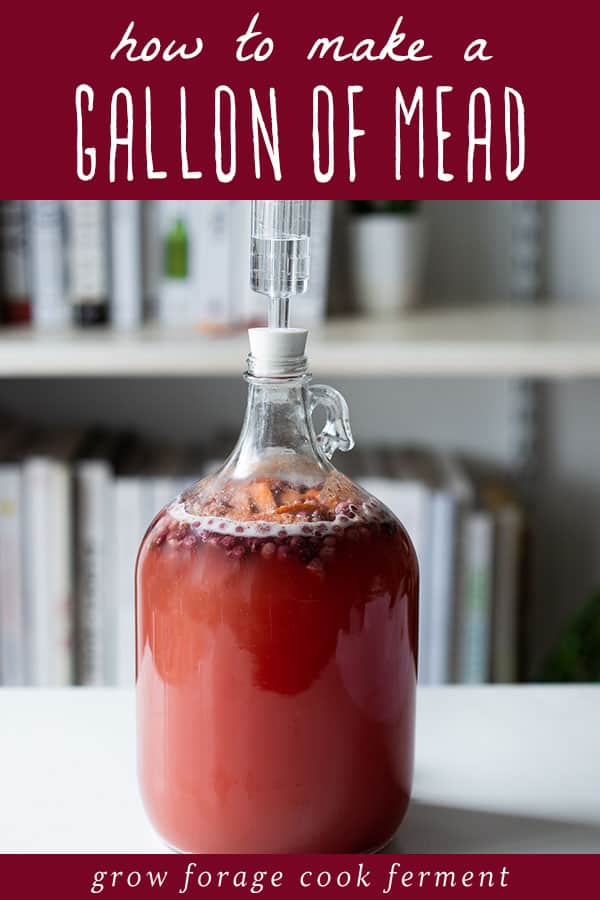
Want to save this post for later?
Simple Mead Making eBook
Want to learn more about making mead? I have a Simple Mead Making for Beginners eBook just for you!
It has ingredient and equipment checklists, detailed instructions for brewing and bottling your mead, and simple mead recipe ideas! Be sure to check it out if you’re new to the mead making process and want a step by step guide.
One Gallon Mead Recipe
Here is my simple method for making one gallon of mead!
What is Mead?
Mead is a fermented alcoholic beverage that is traditionally made with just honey and water, and maybe some yeast (wild yeast is often used).
Whenever you add fruit to mead it’s technically called a melomel rather than mead. I still usually default to calling it mead, though.
You could also use apple cider instead of water and then you’d have what’s called a cyser. If you add herbs and spices or other flavorings it’s called a metheglin.
Mead Equipment and Ingredients
There is some special equipment and ingredients that you will need to make this mead.
Rather than list it all here, I’ve created a page that has links to all of my favorite mead ingredients and equipment: Mead Equipment & Ingredients: Everything You Need to Get Started.
There you will find links to the sanitizer, brewing jugs and buckets, airlocks, yeast, tubing, bottles, and honey and I recommend!
How to Make Mead: One Gallon Mead Recipe
Alright, let’s get started on making this mead!
This is a recipe for one gallon of mead, but I’m always of the mind that if you’re making one you might as well make two.
You can split a package of brewing yeast up between two jugs (one package can make up to 5 gallons of mead).
Sanitize Everything
The first thing to do is sanitize everything that will be used in the brewing process: the jug, airlock, big pot, spoon and funnel.
Simply follow the directions on the sanitizer and don’t throw it out until you’re totally done (just in case your dog licks the funnel or you drop your spoon).
Make the Mead Must
Once everything is sanitized, put about 1/2 gallon of non-chlorinated (filtered) water in a large pot on medium heat. When it’s warm, but not boiling, add the honey and stir until it dissolves.
Using two pounds of honey will make a very “dry” mead (not sweet), while three pounds will create a sweeter mead.
The type of yeast you use will also affect how dry or sweet the mead is.
Turn the heat off. It may be a little foamy, but that’s ok.
In the meantime, put the berries (or any fruit of your liking), orange slices (skin and all), and raisins into the one gallon jug.
Raisins are added as a natural nutrient for the yeast. You will not notice any flavor from them in the finished mead.
Then, using the funnel, carefully pour the honey water mixture (technically called “must”) into the jug.
Top off the jug with cool non-chlorinated (filtered) water, leaving at least 2 inches of head space on top.
Then put the lid on the jug and gently mix everything around a bit. If you bought a jug that came with an airlock it may not come with a lid, so you’ll have to find a lid that fits or improvise a bit here. A solid cork (without a hole for the airlock) would work.
Pitch the Yeast
The next step is to add the yeast, but you need to make sure that it isn’t too hot, which will make your yeast inactive. It should feel lukewarm, no more than 90° F (32° C). I recommend using a thermometer before adding the yeast to be sure.
Once it is less then 90° F you can pitch the yeast into the jug.
You don’t need to use the whole package of yeast for one gallon, 1/2 package is enough (it doesn’t have to be an exact measurement). Store the opened yeast package with the remaining yeast in an airtight zip top bag in the refrigerator for later use.
Now the fermentation fun can begin!
Once you’ve pitched the yeast, put the lid back on tightly and this time you’re really going to shake it up for several minutes.
It’s a good workout for your arm muscles, so you can skip the gym on days when you make mead!
Add the Airlock
Put a little water in the airlock to the line, then put the rubber stopper into the jug.
In a few hours you should start to see bubbles forming in the jug and in the airlock.
After several hours or overnight, you may see a lot of bubbles rising up the neck of the bottle! The whole top might get a little foamy at first, but things will settle down.
Don’t worry if the bubbles rise up into the airlock for the first couple of days, that just means that you have a very active (and happy) batch of mead! You can periodically remove the airlock to rinse it out, then replace it back into the jug.
I love watching all the little bubbles! Fermentation is so cool.
Set Aside to Ferment
Keep the jug in a cool (not cold) dark place out of direct sunlight to ferment.
Mead can take longer to ferment than hard cider or beer, depending on the ambient temperature it will take anywhere from 3-6 weeks.
I usually give it 5-6 weeks before bottling to be on the safe side, as you don’t want any broken bottle explosions! I’ve definitely had some very champagne like mead before.
You want to wait until you don’t see any bubbles in the jug and your airlock is still before bottling.
Bottle the Mead
Bottling one or two gallons of mead is the same process as bottling hard cider. Follow my tutorial there to get a detailed process.
You may want to wait a while to drink your mead as it definitely gets better with age.
I often drink it “green” (young) as I enjoy it either way. It is fun to save a couple of bottles for several months, or even a year, just to see how the taste changes with age.
More Mead Recipes
Now that I’ve shown you how to make this simple one gallon of mead recipe, chances are you will want to make more soon!
I have written posts on How to Make 5 Gallons of Mead and How to Bottle 5 Gallons of Mead if you want to try making a larger batch.
I have one gallon mead recipes for Wildflower Mead, Dandelion Mead, Blackberry Mead, Elderberry Mead, Elderflower Sparkling Mead, and Maple Orange Mead that are all delicious and follow this same basic mead recipe.
See my post on 15 Easy Mead Recipes for Beginners for even more!
If hard cider is your thing, see my posts on brewing hard cider and making hard cider with wild yeast.
Be sure to check out my Simple Mead Making: A Beginner’s Guide to One Gallon Batches eBook for more detailed information on brewing, bottling, and recipe ideas!
Cheers and happy mead making!
Simple One Gallon Mead Recipe
Equipment
Ingredients
- water non-chlorinated or filtered
- 2-3 pounds honey depending on how sweet you want to end product to be.
- berries or fruit of any kind fresh or frozen, about a cup
- 1 orange
- 10 raisins
- 1/2 package champagne yeast or other wine yeast
Instructions
- Sanitize everything that will be used in the brewing process.
- Heat about 1/2 gallon of non chlorinated water in the pot on medium heat. Once it's warm, but not boiling, add the honey and stir it so it all dissolves. Turn off the heat.
- Put the berries or other fruit, orange slices (skin and all), and raisins into the one gallon jug.
- Use the funnel and carefully pour the honey water mixture into the jug.
- Top off the jug with cold (preferably filtered) water, leaving at least 2 inches of head space on top. Put the lid on the jug and gently mix everything around a bit.
- Make sure that the temperature of the must is below 90°F, then add 1/2 packet of champagne yeast. Put the lid back on tightly and this time shake the jug for a minute or two to distribute the yeast.
- Put a little water in the airlock to the line, then put the rubber stopper end into the jug. Put the jug in a dark place. It should start bubbling within 12-24 hours.
- After about 4-6 weeks of fermenting, once all bubbles have stopped rising in the jug and airlock, the mead can be bottled and aged.
Notes
- Please see my Mead Equipment and Ingredients page for a detailed list of what you need to get started.
- Use my tutorial on Bottling Hard Cider to bottle the mead - the process is the same. The flavor of homemade mead will improve after bottling and aging.
- My Simple Mead Making eBook is a helpful resource if you are just getting started with making your own mead.

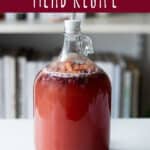


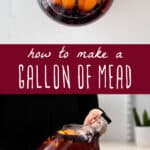
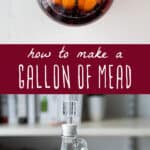
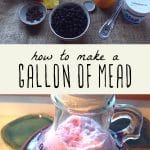
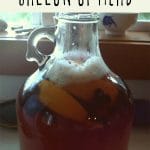
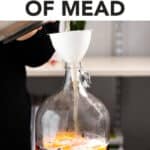
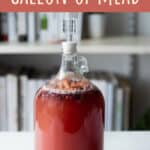
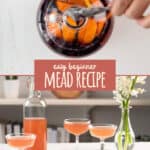




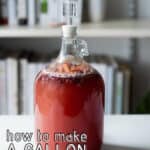
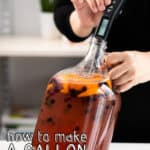
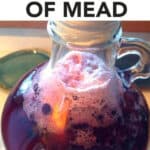
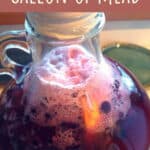
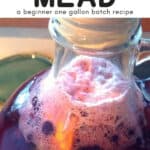
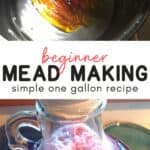
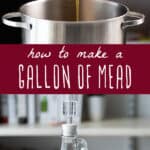
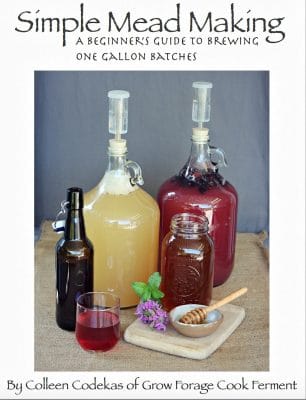


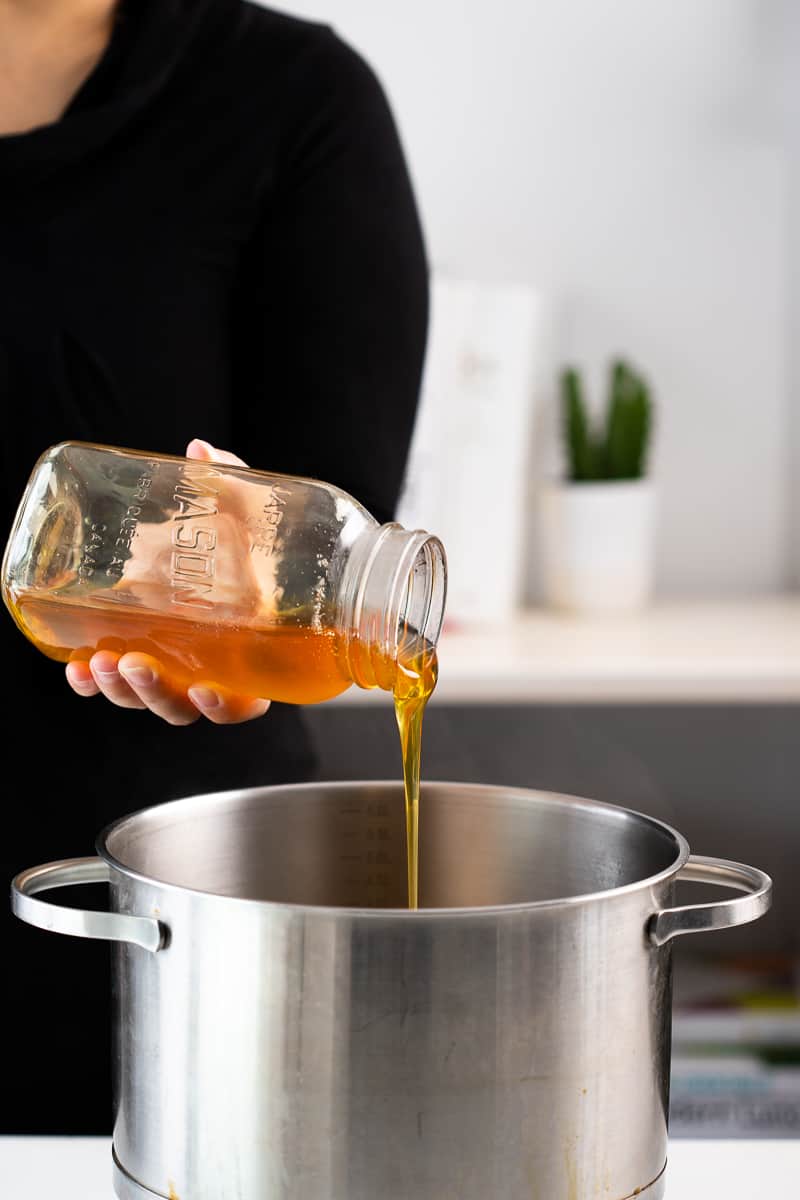
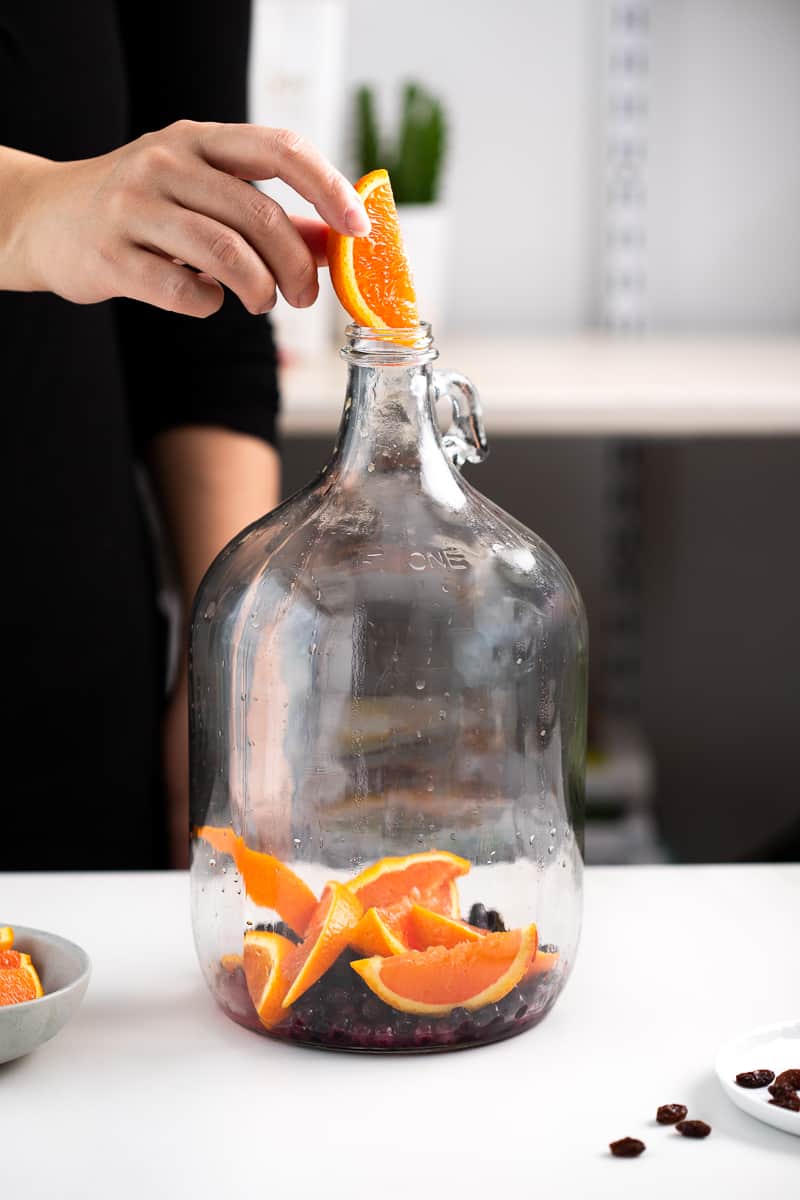
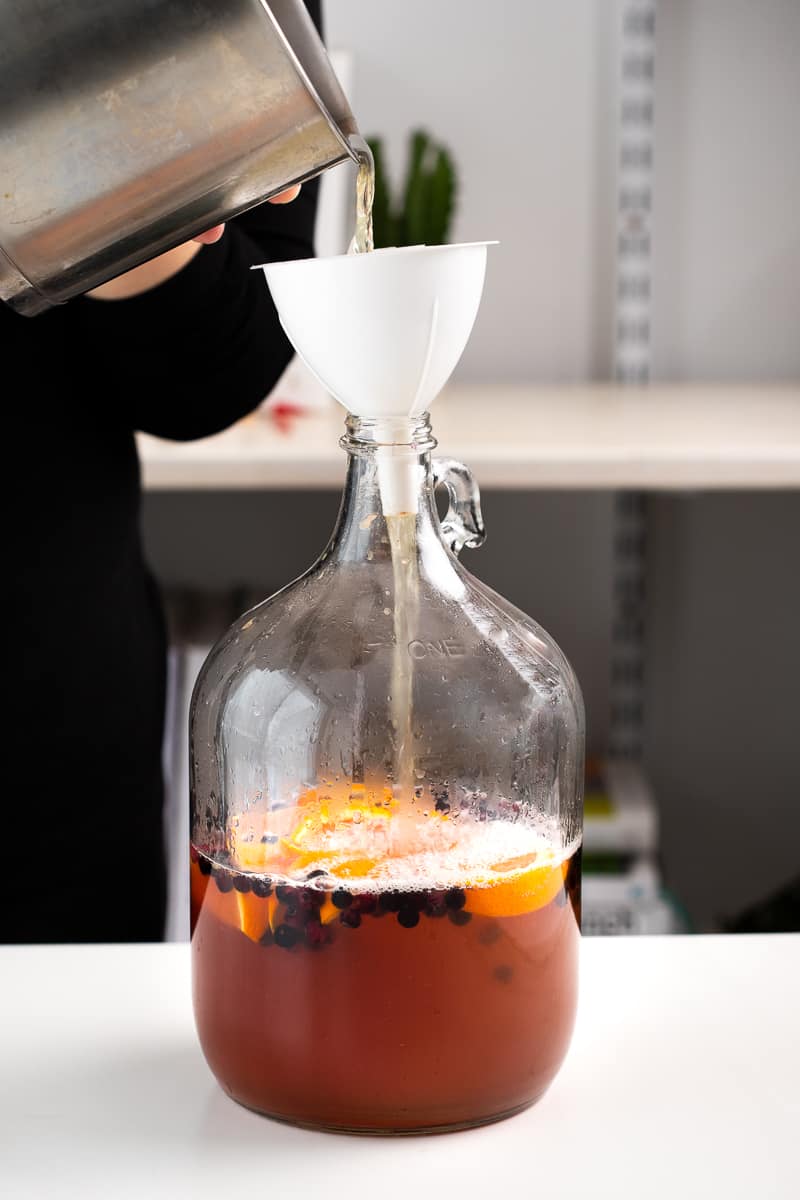
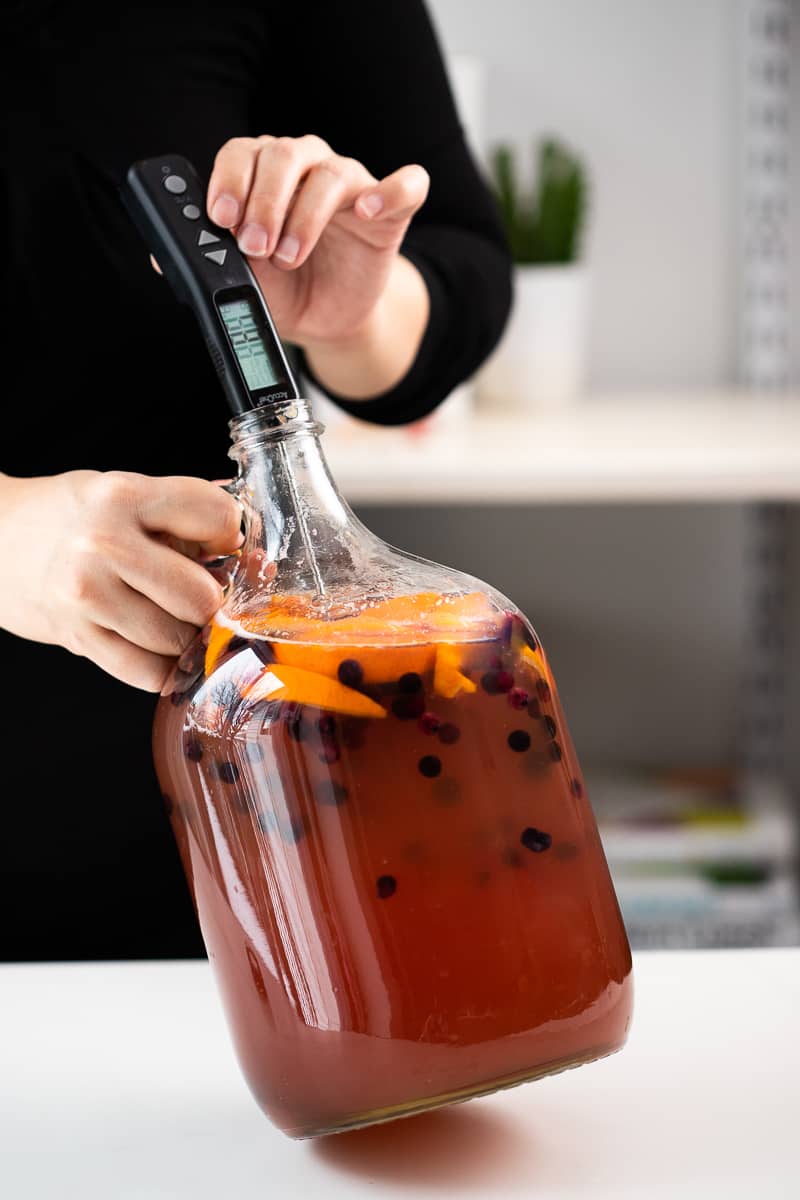
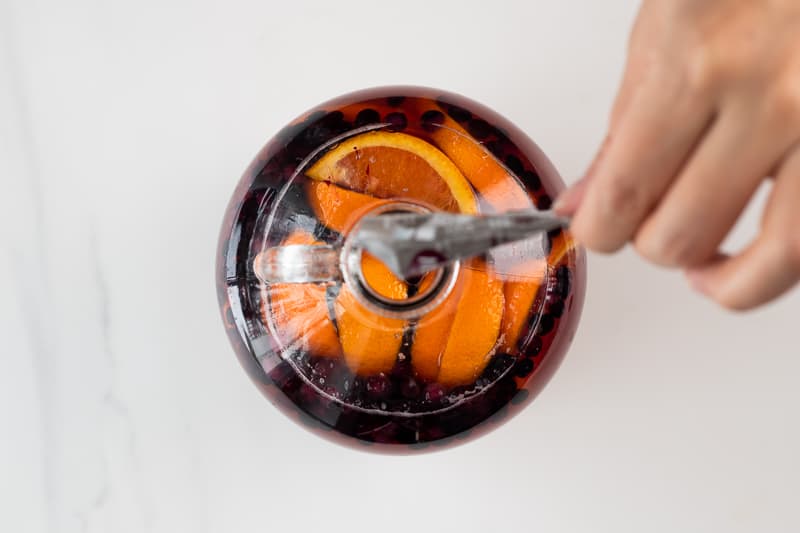

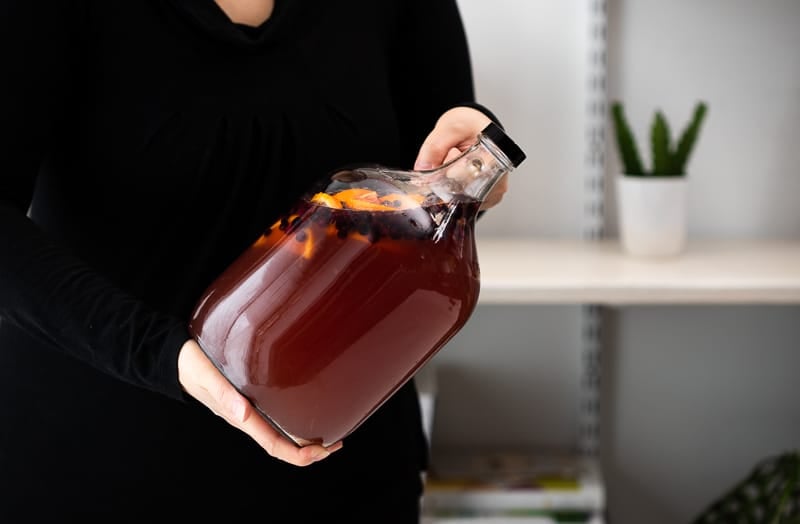
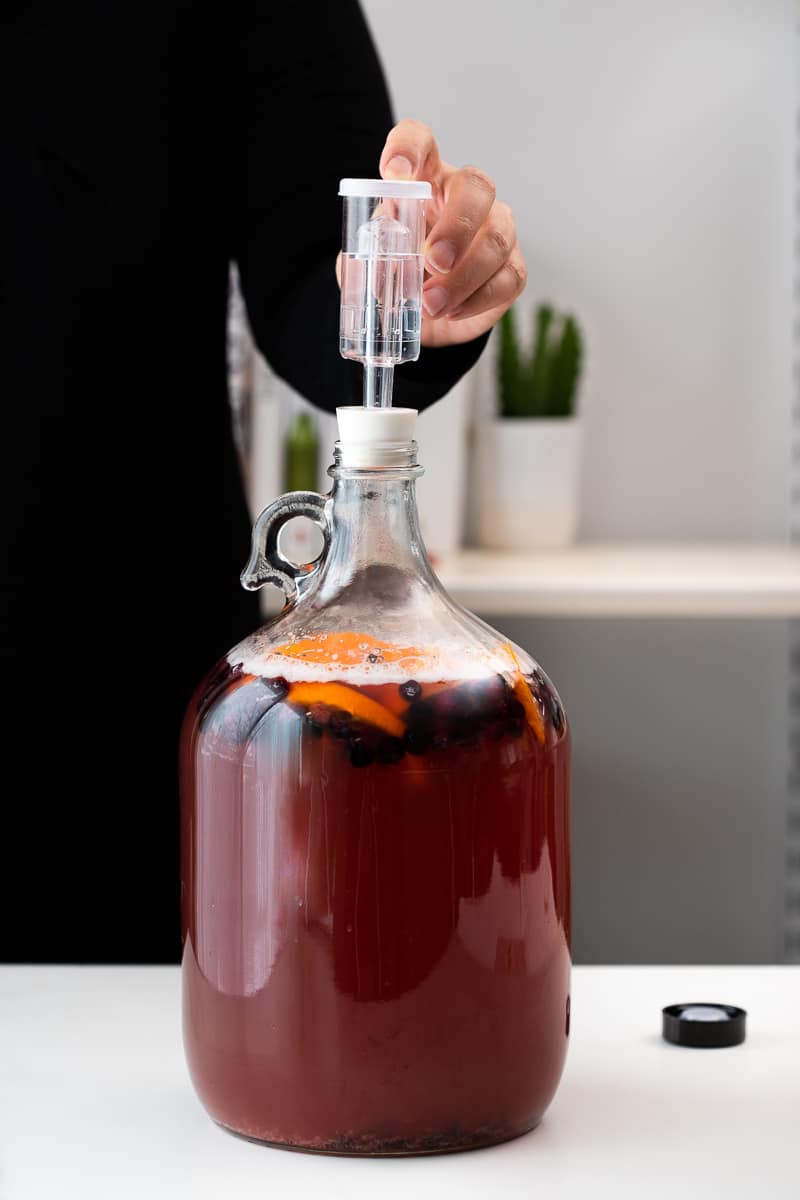
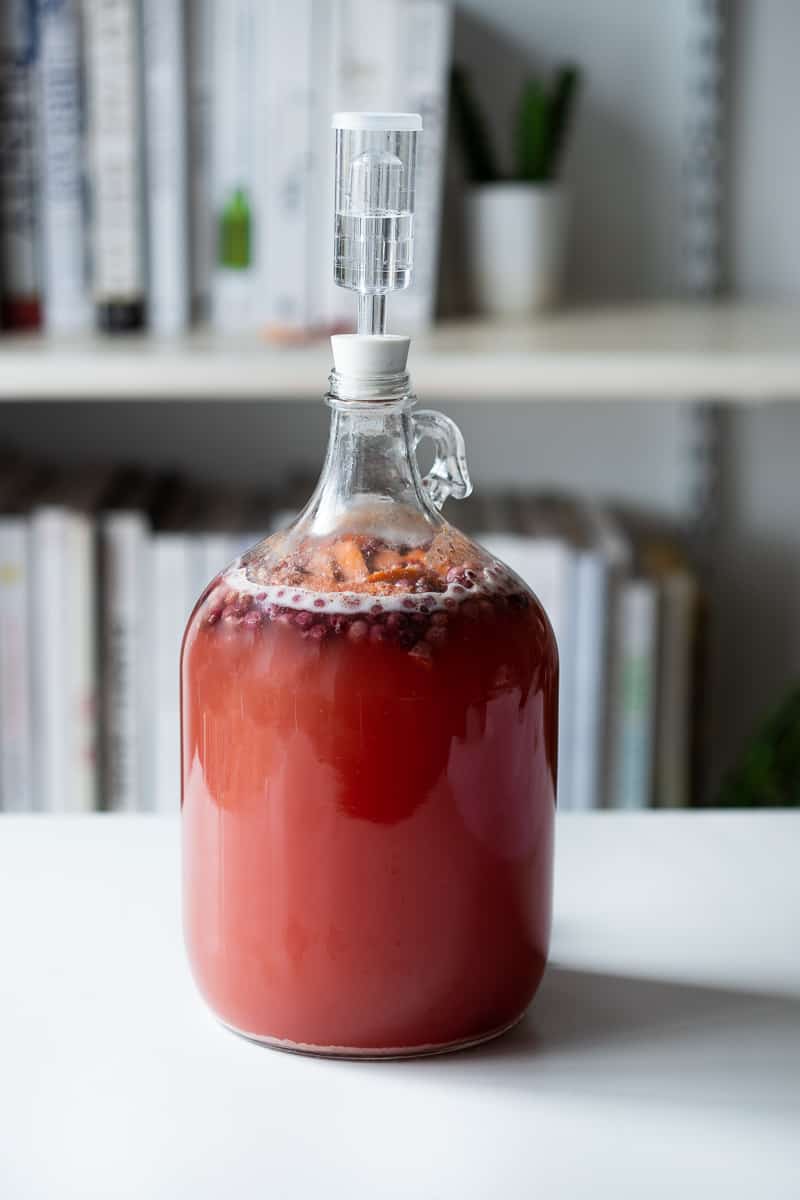



When you mention a ‘sweet’ meade, do you mean SWEET or do you mean ‘sweet?’ I do prefer truly sweet drinks. Thanks for your info and your time!
Having brewed beer, and mead, I can tell you that the PH of the brewing water is crucial to success. I usually buy a couple gallons of spring water. I have a professional grade PH meter, and here in the Midwest the water is often alkaline. A PH too low, or too high affects the yeast metabolism, and can throw of defective flavors. So, I recommend at a minimum that you buy some test strips and look for some acid blend and yeast nutrient, with your ideal fermenting Ph somewhere between 5.0, and 5.5.
I tried this recipe as written with strawberries and blueberries as a must, and there is now a distinctive rotten fruit flavor in the finished product. While not undrinkable, it is also not necessarily pleasant. Any tips for avoiding that in the future?
Hi Alex. I would use the freshest fruit possible. There may have been mold prior to fermentation.
I found your recipe for mead after having a dismal failure of trying pear wine last year. I thnk most of the alcohol went with the large chunks of fruit that the other recipe suggested adding to the wine. I’ve smashed most of the pears this time, dehydrated grapes into raisins, added rind and fruit of a tangelo, and added 7 1/2 pounds of honey for my 4 gallon batch. The gallon batch of blackberry mead I also started today is off gasing bubbles like crazy with 2 1/2 pounds of honey, but the 4 gallon bucket isn’t. Will I need to stir the mead or just let it be? Did I under sweeten the larger batch? I used 1/2 packet of Lalvin wine yeast( burgundy and silver packet) for the gallon, and 1 1/2 packets of the same yeast for the bucket.
It sounds like you did everything right. The larger batch may just need more time to get going.
I just started my first batch of mead and planning on starting another batch. I was wanting to try grapes. Do I need to crush the grapes or can I add the entire grape (skins)? Thank you!
I would probably heat and crush the grapes to extract their juice and use that for the mead.
How do you remove all ingredients out of the bottle. The oranges and all.
I hold the jug upside down over the sink and use a chopstick to pull the fruit out.
I visited a fellow in the 1980’s whose hobby was making and drinking various wines. He made them all in wide mouth jars, one gallon or so i size. They varied a lot. Instead of an airlock he put a plate of glass across the jars. This worked perfectly, and nothing ever got sucked back in. As I have a 10 gallon brewing jug with an airlock I never used this method, but it was quick, easy, and he could reuse the glass, if it didn’t get broken, indefinitely. Would not work with kids, pets or unruly visitors. Anyhow, I thought people with large jars and some glass could use this and spend less $. BTW, I started making wine when I was 14, 61 years ago, made lots of wine and beer at times.
By any chance do you have a recipe for raspberry mead?
I don’t, but you could swap blackberries for raspberries in my blackberry mead recipe.
Can I leave it the raisins and orange?
You could, but I can’t guarantee the flavor will be the same.
Instead of using a gallon glass jug, I’d rather make 5 gallons of mead. Could I use a 5 gallon plastic beer brewing bucket to ferment my mead or would it pick up off flavors from plastic? It would be sanitized with air lock-of course. I would stir the mead instead of shake the 5 gallons, too heavy.
Hi Linda. Yes, you could definitely use a beer brewing bucket if you prefer!
Hi, thanks for this interesting post. I actually made some mead starting at the end of october 2022. The gravity reading stopped changing around january time so i then siphoned it off the lees layer at the bottom into another carboy.
the reason i’m saying this is that you said you bottled after 4 – 6 weeks. i’m finding that despite fermentation definitely having stopped there’s still a lot of CO2 in the mead which means i still get semi regular slight bubbles coming out of the air lock. nothing anywehre near what it was during fermentation – just a couple of bubbles a day probably. i’m just a bit nervous about bottling them if gas is still coming off. i don’t want the bottle to explode obviously…
also out of interest, i’ve found that the batch i’ve made has a sort of slightly sour, yeasty taste. i’ve never actually tried mead before i made this. just wondered what other people’s tasted like really.
Anyway, thanks!
I used 1.35 kgs of raw honey 1 gram of ec 1118 and 1 gram of yeast nutrient to 4.95 ish litres of spring water. I had tried a metheglin previously which was an abject failure so I decided to keep it simple. OG was 1055-60. Its currently 1010 (as of 27-5) still bubbling albeit at rather long intervals. I will read it again next week and hopefully it should be finished. It is already extremely dry and tangy, which is not the taste I was looking for, though the smell is in no way unpleasant. Should I have used less yeast to get a sweeter mead? Will this mellow throughout the ageing process? Or, should I back sweeten? I plan to use bentonite to clarify it when its done primary and rack into a demijohn for a month then rack into an oak cask for two weeks then bottle. If this is a success I will attempt to replicate this recipe! Any advice would be welcome.
Hi Richard. It’ll probably mellow out, but you could try back sweetening it if you feel it needs it.
Hello, looking to try making mead and found your recipe. We bought some large mason jars to make the mead in, do you know of a way to make an at home air lock for it? Also, is it safe to sanitize the equipment with a bleach / water solution instead of buying the sanitizer?
You can use bleach. A ratio of one tablespoon to a gallon of water is generally used, just make sure you’re using unscented bleach!
I added a full packet of yeast by mistake. Is that too much
Hi Matt. That should be fine, but it may ferment more rapidly.
Old Beer brewer here: Just a comment. Fill your airlock with vodka or other spirit. That ensures if, for who knows what reason, you wind up with a pressure differential that forces the liquid back into the must it’s less likely to ruin the batch. [Usual cause – must not cool enough before sealing, warm air above the must cools, contracts, and sucks the airlock dry]. Vodka or everclear preferred since it won’t affect the taste (much) should that happen. Make sure your must reaches at least 165 to kill everything – mold, yeast,bateria, etc. Just because I’m paranoid, doesn’t mean they aren’t out to get me.
Is this mead sparkling or still? What seems to be the most popular choice?
What is the best method to carbonate the mead in the bottle?
This is a still mead. You can learn how to carbonate mead here.
How do you prevent mold growth within your mead. I am 3 days into fermentation of 1 gal of Honey + Grapes and 1 gal of Honey + mixed berries mixture, and I just don’t want to ruin the batches.
Hi Josh. If properly sanitized, mold shouldn’t develop. You may see a white layer form on top of your mead (kahm yeast), but this is totally normal and safe.
Could I put yeast nutrient in the mead?
Sure!
I just bottled my mead. Followed your recipe exactly with adding the more honey per your suggestion. It was a classic fermentation and was ready within the 4-6 week timeframe. I really, REALLY wanted to keep out some to taste but I bottled a perfect 6-20 oz bottles with an inch of headspace. These will wait patiently in my dark closet until late August when we will. Rack open the first for a test while we watch the fireflies. I am going to start another batch today do not know what kind yet….Oh, the possibilities!
So glad you liked this recipe. Enjoy!!
What will the ABV be once finished?
I didn’t check the ABV, so I can’t say.
I’m ready to bottle my mead do I strain the fruit out of it? Others are asking how to get fruit out of the jug surely it is tossed out at this point . Thanks Denese
Yes. I use a siphon to remove the mead off the top of the fruit. Then remove the fruit by pulling it through the top of the jug with a chopstick, if needed. Most of the time, the fruit is so soggy, that it falls right out.
Quick question this is my first batch. Other posts say I should stir the mead every day I’m at 4 weeks and still have plenty of bubbles. I did not stir at all. SHOULD I? I didn’t see anything in your recipe that suggested to stir. Thank you for your time
I personally don’t and never thought it made much of a difference.
Thank you I appreciate your advice.
How long do you typically age your mead for once it’s bottled? How long theoretically could I age it for?
You can age it for years!
Can I forgo the yeast if I an using raw unfiltered, unpasteurized honey?
No. While it may ferment, the flavor will be unpredictable and possibly unpleasant.
I have some honey started to ferment on its’ own. Would this be good for making mead?
Hi Lottie. Fermenting on its own can be tricky and unpredictable. You can try it, but there’s a chance that the flavor won’t be pleasant.
This is not a simple mead. It is a nice recipe for a mead, but a simple mead would just be water, honey and yeast. Five stars for the recipe, one star for calling it simple.
This recipe is potentially dangerous and is missing crucial information. You need to take gravity readings to know if your fermentation has finished or stalled. There is a large potential for exploding glass bottles using these instructions. Shame on you.
Umm, well, isn’t the airlock there to prevent that? It keeps outside air from going in but allows the fermented gasses to escape — thus no dangerous pressure buildup.
I did my own 1 gallon batch several years ago. It stalled, so I did a secondary fermentation (little yeast + a half hand of raisins). The 12 oz bottled mead stood in a refrigerator for about another year.
There was never an explosion!!
I just gave it a tip of teaspoon real sugar prime at the bottling.
I think everyone is really hung up on the prospect of exploding mead.
Fermentation really will stop in a refrigerator…..
Best regards.
The article says to wait until fermentation stops before bottling, even going as far as to say there should be no more bubble activity in the airlock. What you’re suggesting is a way to conclusively determine that fermentation has stopped but I would think if there was no more bubbling in the airlock then whatever fermentation is left is probably enough to blow a glass bottle up, especially if the bottle was designed for fermentation pressures. The only concern after that would be using too much priming sugar if someone is wanting to carbonate their mead.
I am brewing my first Mead to your simple one gal recipe, it is three days on and bubbling wonderfully. There is a creamy looking accumulation gathering in the bottle of the demijohn which I take to be an unused residue of the honey and used yeast cells . Can this be recycled as anything useful ?
I am a wine brewer of many years standing( and falling), have always intended to do a mead, find both your recipe and website first rate.
Regards Brian S
Hi Brian. The leftover lees at the bottom of your demijohn will make a wonderful addition to the compost bin but beyond that, it’s not useful in any way.
How do you manage to empty de demijohn of the fruit? I’m afraid to make a mess and not getting it properly clean, after all.
Thanks.
It’s usually soft enough that it slides right out. If there are any stuck pieces, I’ll use the handle of a fork to pull them out.
Once you bottle the mead, can you put it into the fridge? Or will that take away from the aging process?
Thanks!
That’s right, refrigerating the mead would hinder the aging process. It should be kept at a cool, room temp.
Hi! I had a question. I started my first gallon a few days ago, but now realize that the orange in the recipe isn’t optional. Can I still add it after a few days? Is the fermentation possible without it? There is definitely activity in the pot, but it’s only bubbles and no foam.
I remember making moonshine in my high school chemistry class. One thing we had to do was put the moonshine through a still a few times to make sure only grain alcohol was present…so as not to go blind. I notice you make no mention of distillation. I love mead and want to try this…but worried about safety. Any guidance? Thanks in advance…
Hi there. No, mead does not need to be distilled, the same way beer does not need to be distilled. Also, it’s a myth that moonshine can make you go blind.
I’m going to try my first batch , but from everybody’s info I think it is going to be worth it.
It’s the methanol in the liquor that makes you go blind
If you are in a country where you can make it legally which you can not in the USA throw away the first 50-100 ml that comes out of the still per gallon of mead you are distilling
You certainly can, legally, make moonshine in the USA. The tax evasion associated with bootlegging is the illegal aspect.
I made 2 batches (blueberry, and sweet cherry) that I have just racked. Everything is going very well so far. Great easy recipe.
Any advice on how to hget the orange peels and other frout out of the jug when finished?
Thank you in advance.
I just pull them out with a chopstick.
In general this is a great way to many things out of a glass bottle. Ive used this method to remove stoppers ive accidently pushed into a jug